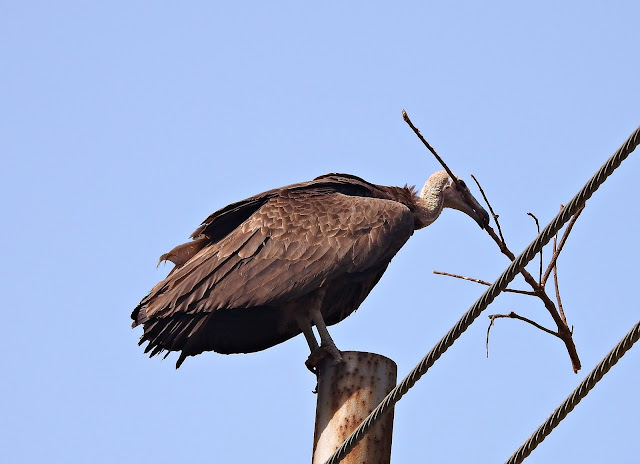A small, mostly brown vulture with a small, naked, pink head covered with velvety white flufflike feathers. The slender, drooping, black beak and blue eye-ring are visible at close quarters and diagnostic when seen. Young birds have gray facial skin and brown fluff on the back of the neck. In flight, note rounded tail and silvery flight feathers. Rare and declining but widespread in open country, forest edge, and towns. While scavenging it is easily displaced from carcasses by larger and more aggressive vultures.

It is the sole member of the genus Necrosyrtes, making this a monotypic genus within the family Accipitridae. This family includes eagles, kites, buzzards and hawks and they diverged from all other bird species 49.6 million years ago, during the Paleogene period. These birds practice monogamy, where males and females remain with one mate during a mating season, and will co-rear their young together as a team. Like other vultures, this species is a scavenger, feeding mostly from carcasses of dead animals and waste which it finds by soaring over savannah and around human habitation, including waste tips and abattoirs. They sometimes referred to as the “garbage collector” by locals.
The major threats to this species include non-target poisoning, capture for traditional medicine and bushmeat – in Nigeria, a survey of medicinal traders found that Hooded Vulture was the most commonly traded species of culture, with 90% of all vulture parts traded belonging to the species, with an estimated 9,000 individuals traded over a six year period in West Africa. Declines have also been attributed to land conversion through development and improvements to abattoir hygiene and rubbish disposal. This species is widespread and found in a large number of protected areas. It is currently being surveyed in parts of its range, with larger scale monitoring planned. The Hawk Conservancy along with the Endangered Wildlife Trust are currently working on providing training and equipment for anti-poisoning teams so that field staff will have the skills and equipment to respond to a neutralise poisoned carcasses.


